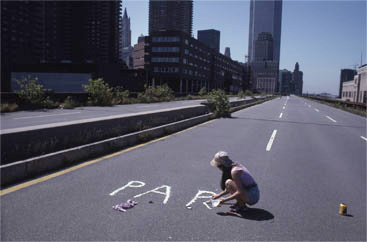
Born in 1948 in Santiago (CL)
Lives and works in New York (US)

1981
Photographs, four digital prints
Dimensions variables
Year of Purchase: 2009
“The opposition between the visual and the oral, between literature and image, and, above all, between sense and intellect, must come to an end. These elements have been arbitrarily disjoined.” 1
Although Cecilia Vicuña is not the author of these lines, her work has always strived to realize them. A Chilean poet and artist, she combines political activism and experimental esthetic practice, with regard to her own country from which she was exiled in 1970, as well as to the successive places of her residence, in particular New York where she has now returned. Since 1966, she has been transgressing the boundaries between cultural disciplines; her own artistic territory is located in the interstices of the arts.
Her works draw on precarios2and visual poems; they employ an economy of artistic means and are “metaphors in space”3. They are small sculptures, installations, or performances featuring found objects, residues of the environment or of History, and words… They are exhibited in all kinds of places, following the spirit of humanism and of authenticity. “Precarious is what is obtained through prayer, uncertain, exposed to risk, to insecurity. From Latin precarius, that which is granted to prayer.”4
Cecilia Vicuña takes photographs in this context of artistic practice; however, she is not in the business of Photography. Parti Sí pasion, New York, 19815 works as an “aid to memory”6, as the trace of a gesture destined to be erased. “Poetry inhabits certain places where cliffs7 just await a signal to come to life. Two or three lines, a mark—and silence begins to speak.”8 As the sole document, the trace replaces the real work completed in New York in 1981: Parti Sí Pasion written in capital letters, using the colours of the Chilean and American flags9, like rock art, painted on the tarmac road leading to the vertical World Trade Center, “this mythical point where the world has been entirely fashioned by man, and which perfectly coincides with his desires (conclusion-fiction)”10.
Parti Sí Pasion, which can be translated as “Share – Yes – Passion”, is a result of the dissection of the word “participation” which, in Manhattan, as much as the word “action”, has taken on a capitalist meaning. Vicuña’s practice of deconstruction of language has produced a body of works she calls palabrarmas, which can be translated as “armswords”, a portmanteau word containing “armas” (arms, weapons) and “palabra” (words)11. “Their internal metaphors are thus exposed to view; people can see the words not as abstractions but as something very real”12.
Cecilia Vicuña juxtaposes Manhattan with the romantic force of her _precario_—her prayer to share in the Passion for and of the world, in the sense of sharing in its Love and in the Christian sense of sharing in its Suffering. In “Parti Sí Pasion” we can also read “la part maudite” (the accursed share)13 of Art which, only if shared among all, will open up a point of exit onto the highway taking us straight to the “stage where the last act of the Western world is taking place”14.
“The world already has the dream of a such a time; it has yet to come into possession of the
consciousness that will allow it to experience its reality”15.
Luc Jeand’heur
1 Joël Pommerat and Joëlle Gayot. Troubles. Actes Sud, 2008.
2 Prayers. (Trans.)
3 Cecilia Vicuña.
4 Cecilia Vicuña.
5 “Parti” in white, “Sí” in blue, “Pasion” – of course – in red.
6 Stéphane Allaire, note for Rem Koolhaas, FRAC Centre.
7 And what cliffs on the horizon: the Twin Towers of the World Trade Center!
8 Another example, “Sud America” has been transformed by the artist into “Sud Ame Rica”, the Rich Soul of the South.
9 See n 5 above.
10 Cf. n 8 above.
11 Cf. n 8 above.
12 Cecilia Vicuña.
13 Georges Bataille.
14 Rem Koolhaas. New York Délire, 1978.
15 Guy-Ernest Debord. The Society of Spectacle. 1967. (fragment 164).